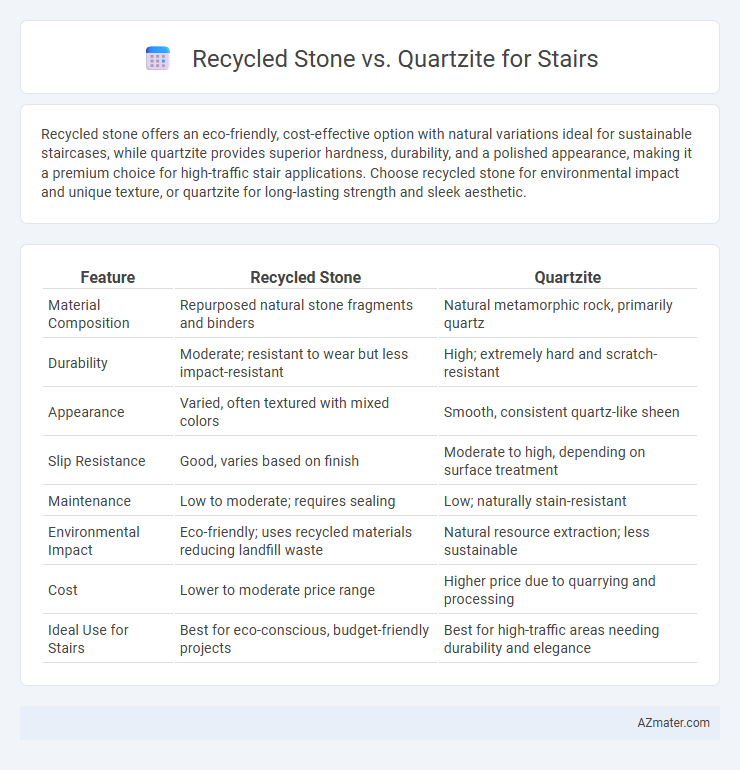Recycled stone offers an eco-friendly, cost-effective option with natural variations ideal for sustainable staircases, while quartzite provides superior hardness, durability, and a polished appearance, making it a premium choice for high-traffic stair applications. Choose recycled stone for environmental impact and unique texture, or quartzite for long-lasting strength and sleek aesthetic.
Table of Comparison
| Feature | Recycled Stone | Quartzite |
|---|---|---|
| Material Composition | Repurposed natural stone fragments and binders | Natural metamorphic rock, primarily quartz |
| Durability | Moderate; resistant to wear but less impact-resistant | High; extremely hard and scratch-resistant |
| Appearance | Varied, often textured with mixed colors | Smooth, consistent quartz-like sheen |
| Slip Resistance | Good, varies based on finish | Moderate to high, depending on surface treatment |
| Maintenance | Low to moderate; requires sealing | Low; naturally stain-resistant |
| Environmental Impact | Eco-friendly; uses recycled materials reducing landfill waste | Natural resource extraction; less sustainable |
| Cost | Lower to moderate price range | Higher price due to quarrying and processing |
| Ideal Use for Stairs | Best for eco-conscious, budget-friendly projects | Best for high-traffic areas needing durability and elegance |
Introduction: Recycled Stone vs Quartzite for Staircases
Recycled stone offers an eco-friendly and cost-effective option for staircases, utilizing materials such as crushed concrete or reclaimed natural stone that provide durability and unique textures. Quartzite, a natural metamorphic rock, delivers exceptional hardness, resistance to abrasion, and a sleek appearance ideal for high-traffic stair treads. Choosing between recycled stone and quartzite depends on balancing sustainability priorities, budget constraints, and desired aesthetic appeal in stair design.
Composition and Origins
Recycled stone for stairs is composed of reclaimed natural stone fragments bound with resins or cement, offering an eco-friendly alternative by repurposing materials from demolished structures. Quartzite, a metamorphic rock derived from sandstone, forms under intense heat and pressure, resulting in a dense, hard surface ideal for high-traffic stair applications. While recycled stone emphasizes sustainability through reuse, quartzite's origin ensures exceptional durability and natural aesthetic variations.
Environmental Impact and Sustainability
Recycled stone significantly reduces landfill waste and minimizes the demand for new mining, leading to lower carbon emissions and resource consumption compared to quartzite, a natural stone that requires intensive quarrying and processing. The use of recycled materials supports circular economy principles, promoting sustainability by repurposing existing stone products rather than extracting fresh resources. Quartzite, while durable and long-lasting, has a higher environmental footprint due to energy-intensive extraction and transportation, making recycled stone the more eco-friendly choice for stair construction.
Durability and Strength
Recycled stone offers moderate durability with variability depending on the source material, while quartzite is renowned for its exceptional hardness and resistance to abrasion, making it highly suitable for stair applications. Quartzite's natural composition provides superior strength and longevity, resisting chipping and cracking even under heavy foot traffic. For staircases requiring maximum durability, quartzite outperforms recycled stone, ensuring long-term structural integrity and aesthetic appeal.
Aesthetic Versatility and Design Options
Recycled stone offers a unique, eco-friendly aesthetic with varied textures and colors that enhance stair design diversity, complementing both rustic and modern interiors with its natural, weathered appearance. Quartzite provides superior durability and a sleek, polished look, available in a wide spectrum of subtle tones and dramatic patterns that elevate staircases with a contemporary, high-end finish. Both materials deliver versatile design options, but quartzite's consistent quality and hardness make it ideal for high-traffic stairs requiring long-lasting elegance.
Installation Process and Maintenance Needs
Recycled stone stairs require a specialized installation process due to variable material thickness and potential irregularities, often needing custom fitting and skilled labor. Quartzite stairs offer a more straightforward installation, benefiting from uniform slab sizes and high durability, which also translates to less frequent maintenance. Maintenance for recycled stone involves sealing to prevent staining and addressing potential surface wear, whereas quartzite demands minimal upkeep, mainly periodic cleaning with pH-neutral products to preserve its natural hardness and shine.
Cost Comparison: Upfront and Long-Term
Recycled stone offers a lower upfront cost compared to quartzite, making it an attractive budget-friendly option for stairs. Quartzite, while more expensive initially due to its natural durability and aesthetic appeal, provides long-term value by resisting wear and reducing maintenance expenses. Over time, quartzite's longevity can offset its higher price, whereas recycled stone may incur additional costs for repairs or replacements.
Slip Resistance and Stair Safety
Recycled stone offers enhanced slip resistance due to its naturally textured surface, making it a safer choice for stairs in wet or high-traffic areas. Quartzite, while extremely durable, often has a polished finish that can become slippery when wet, requiring additional treatments or non-slip coatings for optimal stair safety. Choosing recycled stone can improve stair safety by minimizing slip hazards without compromising aesthetic appeal or structural integrity.
Suitability for Indoor vs Outdoor Stairs
Recycled stone offers excellent durability and weather resistance, making it highly suitable for outdoor stairs where exposure to moisture and temperature fluctuations is common. Quartzite, known for its hardness and sleek appearance, is ideal for indoor stairs, providing a smooth, slip-resistant surface that withstands heavy foot traffic without staining. Selecting recycled stone for exterior use and quartzite for interior stairs ensures optimal performance and longevity in each environment.
Final Recommendation: Choosing the Best Material for Stairs
Recycled stone offers eco-friendly benefits with unique, natural variations perfect for sustainable stair designs, while quartzite provides superior durability, hardness, and resistance to scratches and stains, ideal for high-traffic staircases. For long-term performance and aesthetic appeal, quartzite stands out as the best material for stairs due to its combination of strength and low maintenance requirements. Selecting quartzite ensures a lasting, elegant finish that withstands heavy use without compromising on style or safety.

Infographic: Recycled stone vs Quartzite for Stair
 azmater.com
azmater.com